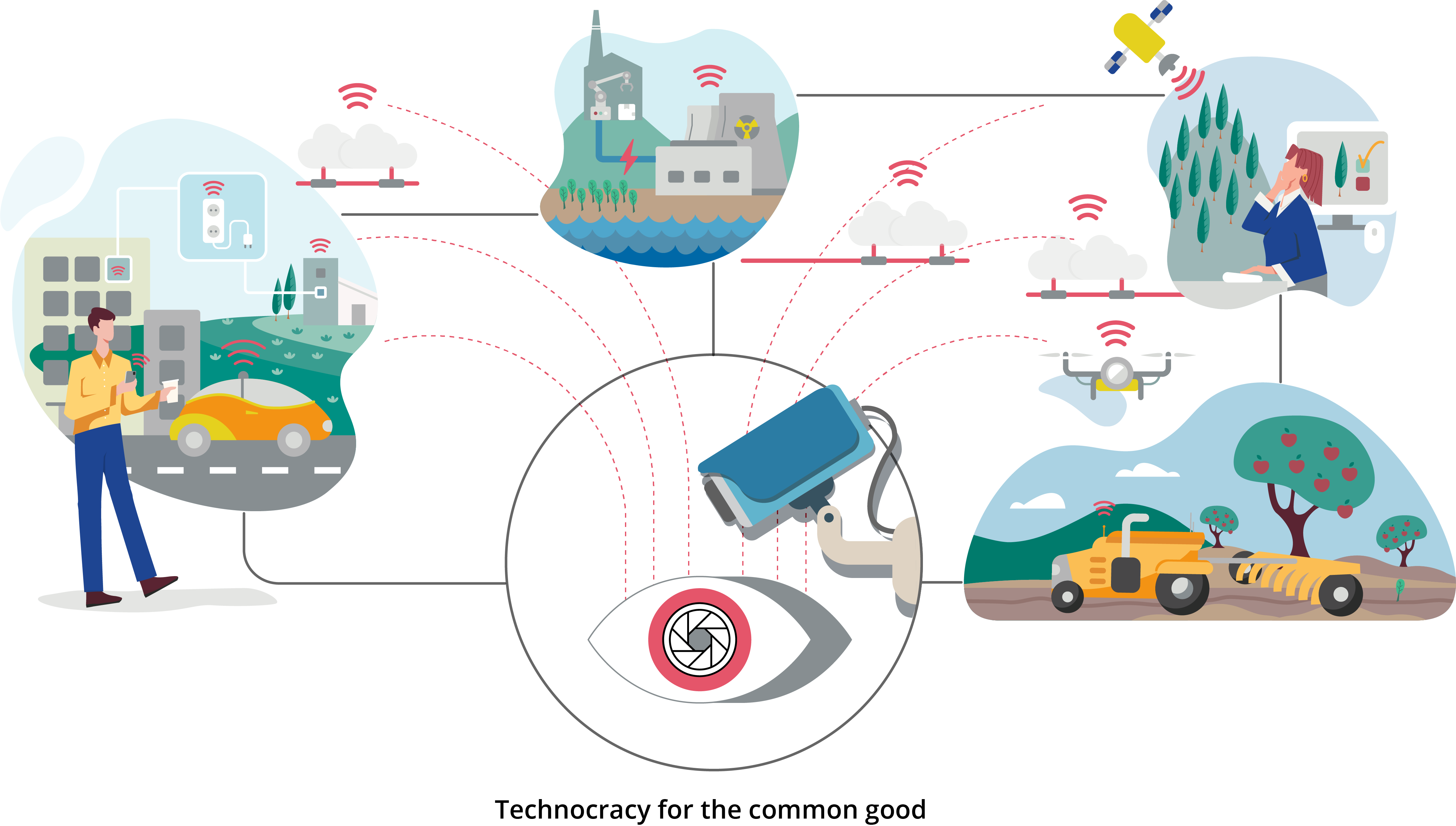Sustainability through state control
In 2050, Europe has achieved high living standards and healthy ecosystems through meticulous, top-down steering of the economy and society. After decades of persistent and growing social and environmental problems, which many blamed on liberalised markets, Europeans have increasingly turned to the state for solutions. An important watershed was the Ukraine war, which was widely understood to demonstrate the necessity of powerful political leadership.

By 2050, national governments have a strong role in organising production and consumption — for example through regulation, market design and taxes — so that economies operate largely within environmental limits. Advanced information and communication technologies and other high-tech innovations enable unprecedented monitoring of ecological, social and economic systems and more efficient use of materials.
Economic growth and big business
Data-intensive planning at the national scale, combined with well-targeted interventions, enable steady economic growth (mainly in the service sector) within environmental boundaries and without social disruptions. However, ‘old industry’ sectors have not disappeared. On the contrary, problems with global supply chains worsened during the 2020s and early 2030s, especially in the aftermath of the Ukraine crisis. European nations had to rethink resource use, and consequently much manufacturing was reshored to Europe. In 2050, some governments provide massive support to 3D printing and circular economy concepts, with a focus on manufacturing, construction and agriculture. Others emphasise compliance with climate protection targets without supporting specific technologies or industries.
State interventions and network economies have contributed to the emergence of ‘big businesses’ that collect vast amounts of behavioural data from users, develop powerful artificial intelligence (AI) tools and dominate their respective industries. While these businesses are potentially influential political actors, governments curb their power and ability to profiteer, for example by imposing strict rules for corporate governance (e.g. relating to remuneration, liability for harms), enforcing rigorous transparency and increasing public ownership in some sectors. The overall aim is to create and sustain a business sector that generates collective societal value before private profit.
The tendency towards centralised governance is reflected in the ways that sectors are structured and operate. For example, the energy system embraces the use of nuclear power and centralised power generation combined with long-distance transfers of energy. This is true even for renewable energy: concentrated solar power and giant photovoltaic fields are favoured over photovoltaic panels on individual houses.

© Designed by Freepik
Agriculture is large scale and intensive, making widespread use of high-tech solutions from AI and robotics to genetically modified crops. Precision farming has made the use of pesticides and fertilisers much more efficient; heavy agricultural machinery is increasingly replaced by swarms of drones and ‘agrobots’ (agricultural robots). From automation to data collection and analysis, the digital evolution of agriculture is a fact of life on farms across Europe. Agricultural yields have increased, production costs have reduced and environmental standards are complied with.
Prioritising society's collective interests
In general, ecosystems and natural resources are primarily valued for their capacity to serve human interests, not for their intrinsic ecological value — the ‘inherent worth of life’ — as the deep ecology movement demands. Consequently, large-scale industries such as fishing and forestry rely on monitoring to secure maximum sustainable yields, often impairing other ecosystem services and reducing resilience.
Sometimes the new concepts of comprehensive real-time ecosystem management are ridiculed as a ‘digital fad’. However, in an age of rapid climate change, weather extremes and frequent calamities, such approaches are a simple necessity. Within cities, advanced planning has expanded green infrastructure as a means of delivering valuable services such as mitigating climate change impacts related to air quality, flood risks and urban heat islands.
The strong performance of national economies generates the fiscal revenues to sustain powerful centralised governments, public services and welfare systems, and to successfully mitigate climate change impacts. This model of governance focuses on maximising the ‘collective interests of society’ for both current and future generations based on a broadly shared understanding of these interests. This sometimes means setting aside individual rights and personal freedoms for the sake of the common good. However, the political system enjoys broad popular support because of the widely shared prosperity and stability that it provides in a world full of crises and conflicts. Behind the scenes, most national governments exert a subtle control over public discourse.
Digital technocracy
The digital transformation pervades all aspects of life, the economy, education, infrastructures and the built environment. Connectivity is ubiquitous. Most citizens interact continuously with a wide array of highly personalised apps. As a consequence, the online public sphere is vibrant, with high levels of participation from citizens, public authorities and businesses. Government uses the latest digital solutions to scan for societal problems or unrest and provide targeted programmes for citizens who are in danger of being marginalised or creating disorder. Pro-social and pro-environmental lifestyles are encouraged through nudging and choice editing.

© Designed by Freepik
Governments have made administrative decision-making as transparent as possible, arguing that this increases acceptance and efficiency. But it is widely rumoured that the primary goal is to limit corruption in powerful state bureaucracies that interact closely with private companies. Civil society organisations have an important role in governance but operate primarily as extensions of government influence, rather than independent and critical voices. Nevertheless, there is a continual complaint on social media about ‘too much control, too many restrictions’. Catchphrases such as ‘Big Brother 4.0’ are occasionally used, for example when some countries introduced personal carbon budgets and again 5 years later when they were made publicly available. This sparked controversies when would-be parents realised that their carbon budget would be insufficient to cover their usual level of consumption and the needs of a child.
In some countries, libertarian groups have emerged protesting against the ‘digital technocracy’. However, political parties increasingly seem to be a thing of the past. Technical experts and their AIs manage many fields of politics in many parts of Europe. However, EU Member States differ substantially in their approaches to regulating personal life, for example in terms of higher or lower privacy standards or the use of bonus/malus systems to promote environmentally sustainable behaviour. In about 2040, attempts to ‘harmonise’ approaches at the EU level failed. Confronted with ‘exit threats’ from some Member States, the EU even devolved some powers. The EU was cut back to a well-functioning partnership among strong national governments, which together focus on protecting their interests and shielding Europe from external pressures, including immigration and economic competition. Despite these differences, all Member States adhere to a broadly similar economic model, leaning towards deglobalisation, self-sufficiency and technocratic management.



Document Actions
Share with others